
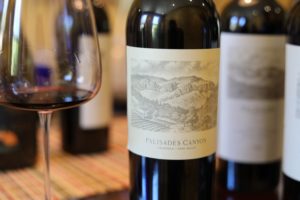
 Palisades Canyon is located in the northern reaches of Napa Valley in the shadow of the rocky Palisades, a part of the Vaca mountain range. This property enjoys a rich history, relating to both prospecting and viticulture and was part of the original Rancho Carne Humana land grant. Immigrants from Scotland, James Horn and his wife Jeannie, purchased 160 acres in 1871 including what is now Palisades Vineyard. A deed from 1878, which noted Horn transferring part of his property to an R.F. Grigsby, references Horn’s already established orchard and vineyard – conceivably these vines may have been planted a few years prior to the deed. These would be among some of the early hillside vineyard plantings in Napa Valley (for reference vines on the Schramsberg’s hillside property were originally planted in the 1860s). The Horns built the still-existing ranch house in 1882. Over the years, the family sold off parts of their property until they sold the remainder (98 acres) in 1893.
Palisades Canyon is located in the northern reaches of Napa Valley in the shadow of the rocky Palisades, a part of the Vaca mountain range. This property enjoys a rich history, relating to both prospecting and viticulture and was part of the original Rancho Carne Humana land grant. Immigrants from Scotland, James Horn and his wife Jeannie, purchased 160 acres in 1871 including what is now Palisades Vineyard. A deed from 1878, which noted Horn transferring part of his property to an R.F. Grigsby, references Horn’s already established orchard and vineyard – conceivably these vines may have been planted a few years prior to the deed. These would be among some of the early hillside vineyard plantings in Napa Valley (for reference vines on the Schramsberg’s hillside property were originally planted in the 1860s). The Horns built the still-existing ranch house in 1882. Over the years, the family sold off parts of their property until they sold the remainder (98 acres) in 1893.
In the early 1900s, an Italian immigrant from Liguria, Domenico Barberis, moved to the northern part of Napa Valley. He was from the small mountain commune of Murialdo (today, less than 900 population) located in the Ligurian province about a 90 minute drive from Genoa. Visitors to the small local cemetery will spot several Barberis gravestones.Highly picturesque and worth visiting are the ruins of the Castello di Murialdo originally built in the middle ages but then mostly destroyed in the 1500s by the order of a governor. The remnants of the castle sit high above town and offer a birds eye view of the village. Remarkably Domenico’s family is not the only Napa Valley wine growing family connected to this village. Cristina Penna Biale of the Biale family in Napa (Biale Winery) immigrated to the U.S. from Murialdo and married Pietro Biale. View our photographs at the end of this review of both the cemetery and the village.
These northern hills are dotted with old mines that produced silver and a handful of other metals. Robert Louis Stevenson’s Silverado Squatters, celebrates this region and the people he met during his honeymoon.
Domenico Barberis originally worked one of these mines near the property. His brother, who was living in Italy at the time, chose a wife for Domenico; Gilda immigrated to the U.S. where she met Domenico for the first time, they married in 1908. In 1907, Domenico purchased this property. The family soon planted and managed their vineyard while raising six children, all of whom were born on the property. Until 1992, their only son Frank Barberis managed the vineyard and sold the grapes to several Napa Valley wineries. Like many other farmers in Calistoga, the Barberis family also had a large plum orchard.
Domenico built the still-standing wooden winery building in 1915. The inside looks like a country barn with a variety of historical items. Period winemaking equipment can be found among the rafters including a vintage conveyor belt and a metal grape hopper. A much-faded sign on the exterior of the structure still marks this as bonded winery number 118, making it one of the oldest in the state.
As with at least one other neighbor (the old Saviez winery, now Davis Estates), Domenico fell on the wrong side of the law by making wine during Prohibition. He played a cat and mouse game with Federal agents for much of Prohibition and in 1923 was arrested on the property for “possession of illicit liquor.” In 1932, a year before Prohibition was repealed, Domenico had to destroy 450 gallons of alcohol (thick lees) in front of Federal agents by pouring it on the ground. The agents then destroyed his tanks. The winery never reopened.
Fast forward decades: 98 acres of the original property was purchased in 1992 by Anne Carver. Anne and her husband Denis Sutro sold grapes to other wineries and brands but also made their own wine bottled under the Carver Sutro label. Denis was a trial lawyer for a few years, but made a dramatic career change and took up carpentry before becoming a vintner and also brokering real estate in Napa Valley and Sonoma County.
Denis told us the couple initially planned on raising their children in the quiet and rural environment. However, the property had a well-established vineyard, so Denis began to learn about viticulture and winemaking, and took related classes at UC Davis. For several years he and Anne sold grapes while simultaneously making small batches of non-commercial wine from the property. The first vintage of Carver-Sutro was from 1998.
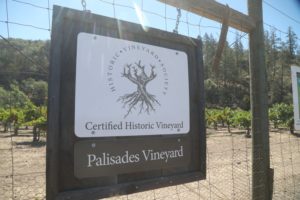
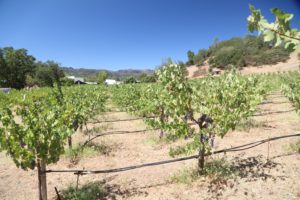
 In 2015 the property changed hands again, this time to Felicia Woytak and Steven Rasmussen, a couple who are passionate about preserving and sharing the property’s unique mineral prospecting history, viticultural provenance and natural beauty. Felicia recalls looking for property for several years, not really sure what they were looking for. But as soon as she walked on this land, she knew it was a special site; she hiked to the top of the property and was brought to tears by an emotional connection to the land. Inspired by these remarkable panoramic vistas, Felicia then committed to take up the mantel of stewardship for Palisades Vineyard.
In 2015 the property changed hands again, this time to Felicia Woytak and Steven Rasmussen, a couple who are passionate about preserving and sharing the property’s unique mineral prospecting history, viticultural provenance and natural beauty. Felicia recalls looking for property for several years, not really sure what they were looking for. But as soon as she walked on this land, she knew it was a special site; she hiked to the top of the property and was brought to tears by an emotional connection to the land. Inspired by these remarkable panoramic vistas, Felicia then committed to take up the mantel of stewardship for Palisades Vineyard.
They own 796 acres of which more than 500 acres are co-owned with one of their neighbors – part of a conservation easement. Palisades Vineyard is planted to 17.5 acres of CCOF certified organically farmed vines, and the variety that is most associated with this property is Petite Sirah. The oldest of these vines date from 1964 with newer plantings in the 1970s. The footprint of this variety is 11.5 acres along with 4.5 acres of Cabernet Sauvignon (with cuttings from several iconic vineyards in Napa Valley), .33 acre of Cabernet Franc and .5 acre of Chenin Blanc and .75 acres of Petit Verdot.
After Felicia and Steve purchased the property, they replanted 5.5 acres of trellised vines to head-trained vines (less yields but higher quality grapes), grafted onto St. George and 110R rootstock – focusing on longer trunk length and canopy management for less radiant exposure.
As of 2023 according to the Napa County Crop Report, there are approximately 20 acres of Chenin Blanc planted in Napa Valley; this has grown slightly from the 2017 Napa County Crop Report which listed merely 7 acres. It should also be noted that as recently as the late 1980s Napa Valley grew several thousand acres of Chenin Blanc. In 2015 Felicia and Steve planted St. George rootstock on 8×8 spacing on about a half-acre of hillside land. In 2017 the rootstock was grafted to Chenin Blanc; in an homage to historical farming techniques, the vines are widely spaced, dry farmed, and head trained.
The challenge with growing this variety in a warm site such as Calistoga is being particularly careful when it is harvested in order to preserve the freshness of the variety without imparting over ripe characteristics. Sometimes depending on weather and temperature, this window can be very narrow. And the farming is critical to the minimalistic winemaking practices favored by the owners.
Steve is quick to admit that to properly maintain a vineyard like this requires the owners live on site and give it their full attention. And he also told us, “The vines farm us, we don’t farm them.”
The vineyard winds its way up the canyon and is divided by Horns Creek. Much of the vineyard is just slightly raised above the valley floor along with several hillside plantings. The property is a mix of volcanic core stones which were part of the original bedrock on the property resulting from an eruption in the vicinity, mostly likely north and east of the property around 2.5 to 3 million years ago. Additional residual soils are a result of the weathering of this decaying bedrock along with alluvial soils and deposits located on the lower parts of the property. Horns Creek bisects the vineyard, and its alluvial deposits form the base material for a number of their vineyard blocks. Parts of their vineyard, where Horns Creek once flowed, are extremely rocky with still sizable rocks located among the rows. Closer to the sides of the canyon, the soils are less rocky and composed of material washed down from the canyon walls.
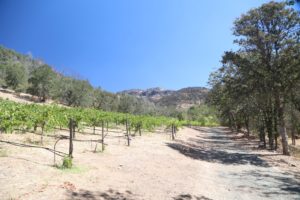
 Felicia and Steve continue to sell grapes to a number of producers. Until a few years ago, one of those customers was winemaker Benoit Touquette. One day, soon after they purchased the property, Benoit mentioned there was a winemaker they needed to meet who appreciates and reveres the viticultural history of Napa Valley. He introduced them to Graeme MacDonald, Winemaker and co-owner of MacDonald Vineyards. Graeme has taken a strong interest in Palisades Vineyard from both a historical and viticultural perspective.
Felicia and Steve continue to sell grapes to a number of producers. Until a few years ago, one of those customers was winemaker Benoit Touquette. One day, soon after they purchased the property, Benoit mentioned there was a winemaker they needed to meet who appreciates and reveres the viticultural history of Napa Valley. He introduced them to Graeme MacDonald, Winemaker and co-owner of MacDonald Vineyards. Graeme has taken a strong interest in Palisades Vineyard from both a historical and viticultural perspective.
Both the property and its passionate and curious owners have attracted a significant amount of talent. Jennifer Rohrs, who has a PhD in plant physiology/pathology and also teaches Viticulture for Winemakers at UC Davis, is their viticulture consultant and David Howell, co-author of The Winemakers’ Dance, has provided invaluable geologic information about their site.
After the Glass Fire burned through a significant portion of the forested parts of their property in 2020, Steve and Felicia worked with Calistoga and Howell Mountain school districts, under the guidance of the Napa County Resource Conservation District, to bring students onto the property as part of an outdoor education curriculum. Accompanied by the vineyard llama named Marquee, the students planted a hedgerow to help restore monarch butterfly and pollinator habitat. The students also planted acorns (now small native oak trees), hiked, and studied the local geology and ecology.
The property experienced a super bloom a year and a half following the Glass Fire. Members of the Napa Valley chapter of the California Native Plant Society visited several times following the fire and were richly rewarded by a variety of flowers only seen following significant periods of stress, including the tall, beautiful and extremely rare Xerophyllum tenax, commonly referred to as the Bear Grass flower.
Mining History
While the canyon above Palisades Vineyard was prospected but never commercially mined, the neighboring Hoisting Works Canyon and the next canyon to the north were the site of the Palisades Mine, developed in 1887 and 1888 by Robert F. Grigsby and partners. Grigsby was the son of Terrill Grigsby, founder of Occidental Winery which is now known as Regusci Winery in the Stags Leap District. Grigsby’s mine was primarily a silver mine, but also gold was extracted during its operation. Hoisting Works Canyon takes its name from the hoisting works machinery built on site to haul ore from deep underground up to the surface where it was put on ore carts mounted on rails. The carts were then sent by gravity through a 700-foot-long horizontal mine shaft to be processed at a separate mill site on the other side of the mountain. Incidentally Grigsby made money from processing the resulting ore from drilling this shaft (despite the fact its drilling was done for transportation purposes).
This mine produced silver and operated until 1893 when it no longer became profitable due to a recession and falling silver prices. A year before, Robert’s youngest son Walter was killed at the mine in an unfortunate accident. Grigsby moved to Mexico to open mines there.
When silver prices rose again, the mine was reopened in 1929 and operated until it was permanently shut down in 1941.
—
In 2021, the friendship between Felicia, Steve and Graeme MacDonald, forged over a common interest in Palisades Vineyard’s viticulture and history, gave rise to a new project to make wines that capture character and beauty of Palisades Vineyard’s canyon below Calistoga’s Palisades. Felicia and Steve have named this new project Palisades Canyon. Graeme (MacDonald Vineyard, Blankiet Estate) is the Winemaker for Palisades Canyon and now plays a strong role in the vineyard development and farm management. His goal with the Palisades Canyon wines is to simultaneously capture the site influence, the warmer weather that Calistoga is known for, but also display some restraint, as he calls it, ‘freshness.’ Starting with the 2021 vintage, Palisades Canyon will offer three varietals from head-trained grapes grown on the property, Cabernet Sauvignon, Petite Sirah, and Chenin Blanc.
Select Wines
Chenin Blanc
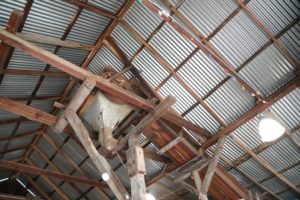
 The 2021 Palisades Canyon Chenin Blanc (tasted from a barrel sample) is medium golden in color; the nose offers aromas of pear and apple and as it opens, reveals a flinty minerality note, hints of dry haystack and some notes of pine needle. This bottling offers bright acidity without being tart and lingers with flavors of lemon / lime juice.
The 2021 Palisades Canyon Chenin Blanc (tasted from a barrel sample) is medium golden in color; the nose offers aromas of pear and apple and as it opens, reveals a flinty minerality note, hints of dry haystack and some notes of pine needle. This bottling offers bright acidity without being tart and lingers with flavors of lemon / lime juice.
Cabernet Sauvignon
The 2021 Palisades Canyon Cabernet Sauvignon was barrel sampled a year post vintage and not yet part of the final blend. It contains a small percentage of Cabernet Franc from the property which was co-fermented with the Cabernet Sauvignon. It was aged in 50% new French oak. This wine is dark ruby with purplish tinges on the edges of the rim in the glass; sometimes with young barrel samples the oak dominates the fruit – not so with this wine. The bouquet offers aromas of bittersweet chocolate, blackberry, dark plum and mulberry and as the wine breathes, it reveals some floral notes including of violets. It is a briary and brambly showing. The tannins are still tightly woven as expected from young head trained vines which are still developing their fully canopy. They feel dusty, dry and are very persistent. Additional barrel age, bottle age and or blending prior to bottling will help soften their impact.
Petite Sirah
Before producing a Palisades Canyon Petite Sirah, Felicia, Steve and Graeme tasted through a number of other Petite Sirah bottlings including those from their own property bottled under other wine brands. They realized that Cabernet Sauvignon centric winemakers who made a Petite Sirah would often heavily extract this variety while those who approached it from a Zinfandel perspective would produce a gentler style of wines. They quickly realized that they preferred the gentler approach, from their perspective resulting in a more elegant wine. Graeme queried some of his winemaker friends who work with this variety including Tegan Passalacqua who offered insights into how this wine was crafted in Napa Valley in the 1950s. This wine is made entirely from free run juice, fermented using indigenous yeast, and racked to barrel when it is still sweet (typically between 8 and 10 brix); it spends up to two years in barrel before being bottled.
The 2021 Palisades Canyon Petite Sirah (barrel sampled a year post vintage) can be easily identified in their new lineup of wines due to its dark and inky looking color. One cannot see through it in the glass; this wine is the definition of opaque. The bouquet is dominated by fruit (rather than oak) in its youthful state with aromas of boysenberry and mulberry which transitions to more of a floral note as the wine evolves including violets. It also shows a savory quality including scents of dried herbs. For such a young wine, the tannins are remarkably well resolved at this stage showing a rounded and dusty texture. The finish lingers with mouthwatering acidity and some darker spices including pepper. This wine is built for the long-haul but is certainly comfortable in its stature, at a very early age.
—
The wine label for Palisades Canyon was designed by iconic label creator, Chuck House of Icon Design Group (Alpha Omega, Buena Vista, Chateau Montelena and Stag’s Leap Wine Cellars among numerous others). The label highlights the site with a view from their lower vineyards looking east towards the upper rocky Palisades.
Felicia and Steve eventually hope to build a new winery on their site. Their wines are produced in very limited quantities and are sold direct to consumer. If you want to follow their next foray into winemaking with winemaker Graeme MacDonald, you can sign up for information at www.palisadescanyonwines.com.
Murialdo, Italy
Murialdo Cemetery

























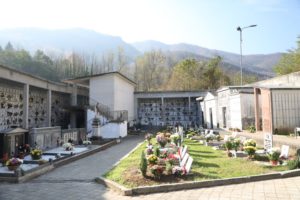

Leave a Reply